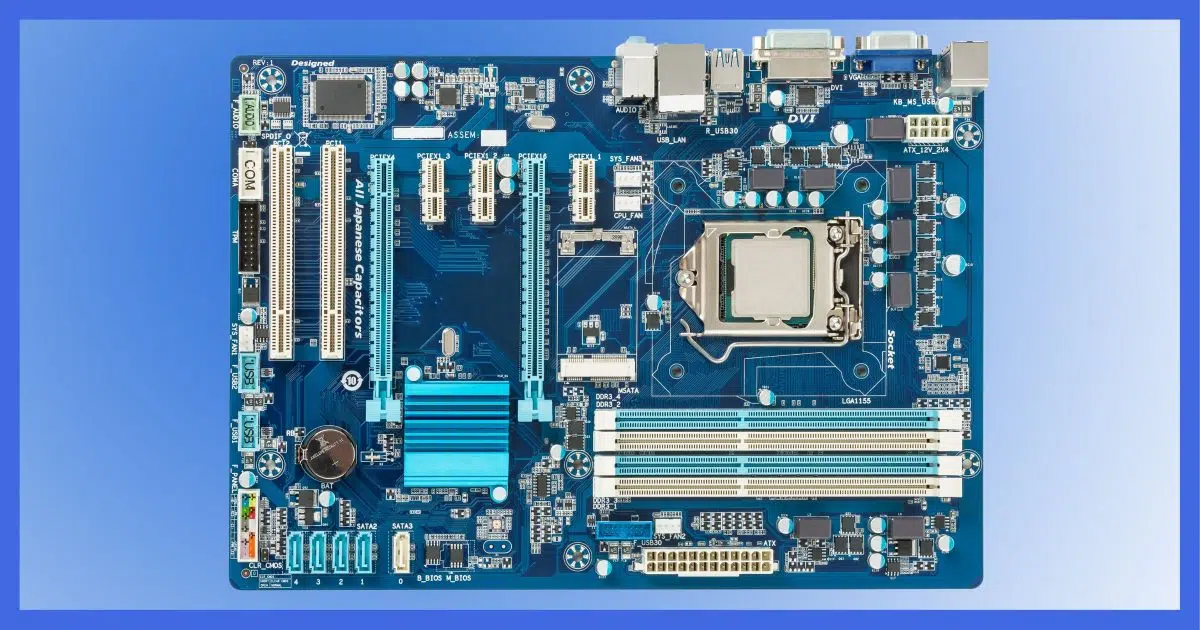It’s worth a shot, but be prepared for the worst.

Unfortunately, the best I can offer you is a maybe. Depending on how much has changed, it might or might not work.
But it’s worth a try.

Replacing a motherboard
You might not even need your backup, as it’s possible (though not guaranteed) the system will just work after the replacement. If not, either repair installs or complete reinstalls of Windows might call for you to restore data from your backup.
Changing the foundation
The problem is that your hard drive and its image backup is configured for and contains the drivers for your old motherboard.
Put another way, that backup mage may not have the drivers necessary to work properly on the new motherboard.
Here’s the kicker, though: sometimes Windows can be really resilient in the face of change. After you upgrade the motherboard, it might notice that something’s changed and automatically install the appropriate drivers for it, or automatically configure itself as appropriate for what it’s found.
Or not. It might crash completely. Or it might boot and limp along poorly. Or something else short of just working.
There’s no way to tell going in.
Help keep it going by becoming a Patron.
So, try it!
I recommend you go ahead and give it a whack.
You may not even need your backup image. Just reconnect the existing hard drive that has everything installed on it and boot the machine. Replacing the motherboard should not have affected the hard drive’s contents.
If it works, great! Run it for a while before making any long-term commitments, though. Exercise the software you have installed and any hardware attached to ensure everything is working as it should.
If it is, congratulations, you’re done!
Repairing Windows
If giving it a try doesn’t work at all, or if it seems unstable, the next thing I would have you do is to boot from Windows installation media (you can download it) and perform what’s called a refresh or repair install.
It reinstalls Windows as if it were a new version on top of the preexisting copy of Windows. It will then select all the right drivers for this new motherboard.
It should also preserve your settings and installed software. (Though, as always, be prepared for that not happening. You have your backup image.)
Reinstall from scratch
The worst-case scenario is where the options above either don’t work or result in an unacceptably unstable system.
The only step left is the nuclear option: use the installation media to perform a completely fresh installation of Windows. This will erase everything that’s already on the hard drive.
You will then need to reinstall all of your applications from their original media or original downloads, and then import your data from your backup or wherever else you have it.
Do this
You’ve already done the most important thing: backed up your machine. No matter what happens, you have that as something you can restore from, or at least recover important files from.
I wish there were a simple thing for you to do here. Part of me would love to tell you that a simple motherboard replacement is likely to just work. Windows has become more resilient over the years. But the possibility still exists that the change might be too great and you’ll need to take more severe steps.
Here’s something the opposite of severe: Subscribe to Confident Computing! Less frustration and more confidence, solutions, answers, and tips in your inbox every week.




Replacing the motherboard/CPU/RAM or building a completely new computer is one reason I sync my files with OneDrive, using it as an off-premises backup solution. Another is the possibility of some major catastrophe. If something really bad happens, I decide to build a new computer, or upgrade what I have, I can simply install Windows on the new hardware (fresh install) and set it up with my existing Microsoft account. After setup finishes, and I am booted into my new desktop environment, all my files will appear on my computer as if they were always there (almost like magic :)). The only task that remails will be installing my applications. I keep a list on OneDrive and the installers on a second drive that I can easily move to the new system during the hardware setup.
To make this work, I keep a D: drive (partition). On it I keep an ‘Installed Software’ folder. In that folder, on the first day of each month, I look through the installers I may have downloaded during the past month. If there are any, I cut/paste the most current version of each application’s installer to “D:\Installed Software” and delete any older installers, from both the “D:\Installed Software” and “Downloads” folders. This way I start the month with a clean Downloads folder, and my Installed Software folder is up to date. After completing this step. I open my apps list (from OneDrive) and update it if there are any new app installers in my “D:\Installed Software” folder. If I decide I’m going to make any major changes to my computer, or build a new one, I check my Downloads/Installed Software folders and my list to make sure everything’s up to date.
My two most important ‘secrets’ to upgrading/building one of my computers are forethought and planning.
I hope this information helps others,
Ernie
I have Microsoft 365. I have a sub-folder on OneDrive that has most of my installation files. I don’t have a backup of MS Office, Windows and others which are easily downloaded. For those, I keep a copy of the serial numbers and other information need to reinstal.
Keeping them on the same physical drive as your OS leaves them vulnerable to loss unless they are backed up-